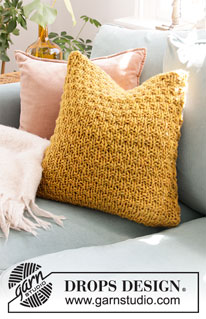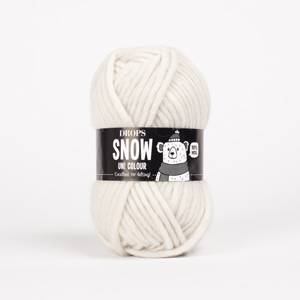Comments / Questions (9)
![]() Jolanda Steiner wrote:
Jolanda Steiner wrote:
Ich werde mir dieses Kissen als Schal stricken 😄
31.05.2023 - 16:29
![]() Britta Nilson wrote:
Britta Nilson wrote:
Hej! Garnet räcker inte! Stickfastigheten följer jag. Behöver ytterligare 1 garnnystan till varje kudde. Har dessutom köpt garnet till en kudde till men i en annan färg. Köpt drops snowmix då kundtjänst som jag pratade med på telefon rekommenderade detta garnet till kuddarna och mönstret. Köpt via nätet. Tråkigt! Annars jättefint mönster! Hoppas ni bjuder på frakten när jag måste köpa mer garn! Dessvärre får man väl inte samma färgbad…
12.05.2023 - 14:29
![]() Karoline wrote:
Karoline wrote:
Har fulgt strikkefastheten men til tross for dette klarer jeg ikke å holde meg til oppgitt garnmengde på 200 gr Snow. Regner med jeg havner på +/- 250 gr. Noe irriterende da "oppgitt " mengde garn til 3 puter er kjøpt på nett.
13.11.2022 - 14:09
![]() Nicole wrote:
Nicole wrote:
Hallo, ich habe das Kissen mit 2 Fäden Alaska-Wolle gestrickt und 400g (8 Knäuel) benötigt. Die angegebene Wollmenge von 200g Snow (200m Lauflänge) können nicht korrekt sein, da diese Menge nur für 70cm ausreichen und ich insgesamt 510m Lauflänge Alaska benötigt habe. I needed 400g of Alaskan wool (8 balls of wool) to get the pillow ready. The specified amount of 200g snow (220yds) cannot be correct, because I needed a total of 566yds running length Alaska (2 threads !).
24.10.2021 - 19:44DROPS Design answered:
Dear Nicole, Snow is from group E and Alaska from group C. Since you work with 2 threads of Alaska, it should be approx. like DDROPS Snow, but it's slightly thicker, so you would need more than double the yards than with just Snow. There can be a difference too depending on the gauge. Happy knitting!
01.11.2021 - 14:02
![]() Michaele Kličková wrote:
Michaele Kličková wrote:
Hallo, das Garn reichte leider nicht, ich musste 3 Päckchen nachbestellen. Aber sonst schönes Kissen.
06.03.2021 - 16:10
![]() Vero wrote:
Vero wrote:
Hei, kan det stemme at det trengs mere garn enn de 200g som er oppgitt? Har kommet til 70 cm nå med 4 nøster, strikkefastheten stemmer.
01.01.2020 - 21:19
![]() Uta wrote:
Uta wrote:
Hallo, ich habe das schöne Kissen gestrickt. Ich habe 200 Gramm DROPS Eskimo benötigt. Viele Grüße Uta
11.10.2019 - 12:04
![]() Sussi Johansen wrote:
Sussi Johansen wrote:
Hej igen. Jeg har nu strikket 1 ngl. garn, og er nået 16 cm. Jeg skal op på 84 cm, så der er behov for 6 ngl. Eskimo, altså ikke 3 ngl., som der står i opskriften. Mange hilsener Sussi Johansen Brøndby
19.09.2019 - 08:57
![]() Sussi Johansen wrote:
Sussi Johansen wrote:
Jeg agter at strikke denne skønne pude. Men.... kan det passe at der kun skal bruges 3 ngl. garn? Venlig hilsen Sussi Johansen
18.09.2019 - 11:05DROPS Design answered:
Hej Sussi, Tak for info, vi skal sørge for at få det rettet :)
26.09.2019 - 09:57
Tea and Honey Pillow#teaandhoneypillow |
|||||||
 |
 |
||||||
Knitted cushion cover with textured pattern in DROPS Snow or DROPS Wish. Fits cushion size 50x50 cm = 19 3/4”x19 3/4”.
DROPS 207-46 |
|||||||
|
------------------------------------------------------- EXPLANATIONS FOR THE PATTERN: ------------------------------------------------------- PATTERN: See diagram A.1. ------------------------------------------------------- START THE PIECE HERE: ------------------------------------------------------- CUSHION COVER – SHORT OVERVIEW OF THE PIECE: The piece is worked back and forth; the front is worked upwards, then the back downwards. The piece is folded and the bottom and sides sewn together. COVER: Cast on 46 stitches with circular needle size 8 mm = US 11 and Snow or Wish. Work diagram A.1 over all stitches (= 23 repeats of 2 stitches) – REMEMBER THE KNITTING GAUGE. When the piece measures 42 cm = 16½" insert a marker = top of cover; you are half-way. Continue A.1 back and forth over all stitches until the piece measures 84 cm = 33". Bind off with knit over knit and purl over purl. ASSEMBLY: Fold the piece at the marker so the cast-on and bind-off edges are together – right side out. Sew the one side together, edge to edge in the outermost loop of the outermost stitch. Sew the bottom edge together and insert the cushion. Sew the last side together. |
|||||||
Diagram explanations |
|||||||
|
|||||||

|
|||||||
Have you finished this pattern?Tag your pictures with #dropspattern #teaandhoneypillow or submit them to the #dropsfan gallery. Do you need help with this pattern?You'll find 13 tutorial videos, a Comments/Questions area and more by visiting the pattern on garnstudio.com. © 1982-2025 DROPS Design A/S. We reserve all rights. This document, including all its sub-sections, has copyrights. Read more about what you can do with our patterns at the bottom of each pattern on our site. |
|||||||


















































Post a comment to pattern DROPS 207-46
We would love to hear what you have to say about this pattern!
If you want to leave a question, please make sure you select the correct category in the form below, to speed up the answering process. Required fields are marked *.